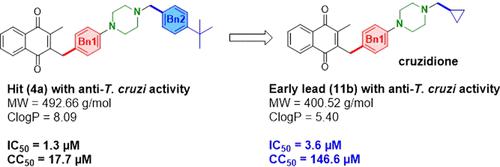当前位置:
X-MOL 学术
›
ACS Infect. Dis.
›
论文详情
Our official English website, www.x-mol.net, welcomes your feedback! (Note: you will need to create a separate account there.)
Synthesis and Anti-Chagas Activity Profile of a Redox-Active Lead 3-Benzylmenadione Revealed by High-Content Imaging
ACS Infectious Diseases ( IF 5.3 ) Pub Date : 2024-04-12 , DOI: 10.1021/acsinfecdis.4c00137 Nathan Trometer 1 , Jérémy Pecourneau 1 , Liwen Feng 1 , José A. Navarro-Huerta 1 , Danielle Lazarin-Bidóia 2 , Sueli de Oliveira Silva Lautenschlager 2 , Louis Maes 3 , Amanda Fortes Francisco 4 , John M. Kelly 4 , Brigitte Meunier 5 , Monica Cal 6, 7 , Pascal Mäser 6, 7 , Marcel Kaiser 6, 7 , Elisabeth Davioud-Charvet 1
ACS Infectious Diseases ( IF 5.3 ) Pub Date : 2024-04-12 , DOI: 10.1021/acsinfecdis.4c00137 Nathan Trometer 1 , Jérémy Pecourneau 1 , Liwen Feng 1 , José A. Navarro-Huerta 1 , Danielle Lazarin-Bidóia 2 , Sueli de Oliveira Silva Lautenschlager 2 , Louis Maes 3 , Amanda Fortes Francisco 4 , John M. Kelly 4 , Brigitte Meunier 5 , Monica Cal 6, 7 , Pascal Mäser 6, 7 , Marcel Kaiser 6, 7 , Elisabeth Davioud-Charvet 1
Affiliation

|
Chagas disease, or American trypanosomiasis, is a neglected tropical disease which is a top priority target of the World Health Organization. The disease, endemic mainly in Latin America, is caused by the protozoan Trypanosoma cruzi and has spread around the globe due to human migration. There are multiple transmission routes, including vectorial, congenital, oral, and iatrogenic. Less than 1% of patients have access to treatment, relying on two old redox-active drugs that show poor pharmacokinetics and severe adverse effects. Hence, the priorities for the next steps of R&D include (i) the discovery of novel drugs/chemical classes, (ii) filling the pipeline with drug candidates that have new mechanisms of action, and (iii) the pressing need for more research and access to new chemical entities. In the present work, we first identified a hit (4a) with a potent anti-T. cruzi activity from a library of 3-benzylmenadiones. We then designed a synthetic strategy to build a library of 49 3-(4-monoamino)benzylmenadione derivatives via reductive amination to obtain diazacyclic benz(o)ylmenadiones. Among them, we identified by high content imaging an anti-amastigote “early lead” 11b (henceforth called cruzidione) revealing optimized pharmacokinetic properties and enhanced specificity. Studies in a yeast model revealed that a cruzidione metabolite, the 3-benzoylmenadione (cruzidione oxide), enters redox cycling with the NADH-dehydrogenase, generating reactive oxygen species, as hypothesized for the early hit (4a).
中文翻译:

高内涵成像揭示氧化还原活性先导 3-苄基甲萘醌的合成和抗恰加斯活性特征
恰加斯病或美洲锥虫病是一种被忽视的热带疾病,也是世界卫生组织的首要目标。这种疾病主要在拉丁美洲流行,由原生动物克氏锥虫引起,并由于人类迁徙而在全球传播。传播途径有多种,包括媒介传播、先天性传播、口腔传播和医源性传播。不到 1% 的患者能够获得治疗,依赖于两种旧的氧化还原活性药物,这些药物的药代动力学较差,且副作用严重。因此,下一步研发的重点包括(i)新药/化学类别的发现,(ii)用具有新作用机制的候选药物填充管道,以及(iii)迫切需要更多的研究和获得新的化学实体。在目前的工作中,我们首先从 3-benzylmenadiones 文库中鉴定出具有有效抗克氏锥虫活性的命中 ( 4a )。然后,我们设计了一种合成策略,通过还原胺化构建 49 种 3-(4-单氨基)苄基甲萘醌衍生物库,以获得二氮杂环苯并(o)基甲萘醌。其中,我们通过高内涵成像鉴定出抗无鞭毛体“早期先导” 11b(以下称为 cruzidione),显示出优化的药代动力学特性和增强的特异性。酵母模型研究表明,克鲁齐二酮代谢物 3-苯甲酰甲萘二酮(克鲁齐二酮氧化物)与 NADH 脱氢酶一起进入氧化还原循环,产生活性氧,正如早期击中的假设 ( 4a )。
更新日期:2024-04-13
中文翻译:

高内涵成像揭示氧化还原活性先导 3-苄基甲萘醌的合成和抗恰加斯活性特征
恰加斯病或美洲锥虫病是一种被忽视的热带疾病,也是世界卫生组织的首要目标。这种疾病主要在拉丁美洲流行,由原生动物克氏锥虫引起,并由于人类迁徙而在全球传播。传播途径有多种,包括媒介传播、先天性传播、口腔传播和医源性传播。不到 1% 的患者能够获得治疗,依赖于两种旧的氧化还原活性药物,这些药物的药代动力学较差,且副作用严重。因此,下一步研发的重点包括(i)新药/化学类别的发现,(ii)用具有新作用机制的候选药物填充管道,以及(iii)迫切需要更多的研究和获得新的化学实体。在目前的工作中,我们首先从 3-benzylmenadiones 文库中鉴定出具有有效抗克氏锥虫活性的命中 ( 4a )。然后,我们设计了一种合成策略,通过还原胺化构建 49 种 3-(4-单氨基)苄基甲萘醌衍生物库,以获得二氮杂环苯并(o)基甲萘醌。其中,我们通过高内涵成像鉴定出抗无鞭毛体“早期先导” 11b(以下称为 cruzidione),显示出优化的药代动力学特性和增强的特异性。酵母模型研究表明,克鲁齐二酮代谢物 3-苯甲酰甲萘二酮(克鲁齐二酮氧化物)与 NADH 脱氢酶一起进入氧化还原循环,产生活性氧,正如早期击中的假设 ( 4a )。



























 京公网安备 11010802027423号
京公网安备 11010802027423号